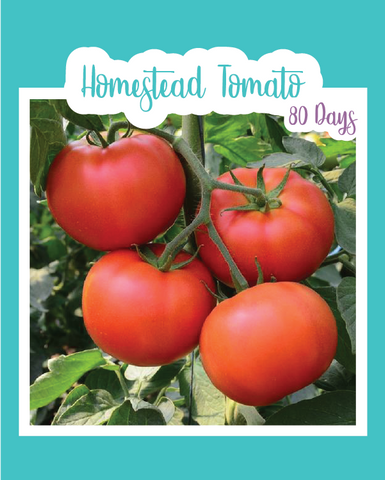
Floradade Tomato
Determinate
Seed Count: Approx. 20 seeds
Days to Maturity: 74 Days
Description: The Floradade tomato is a disease resistant variety bred by the University of Florida known for its heat and drought tolerance. It is one of the best tomatoes to grow in hot, humid climates for consistently high yields, and adapts well to dry areas too! It can withstand heat up to 100 degrees, and doesn't require cooler nights to keep producing tomatoes! The Floradade produces lots of bright red, smooth, jointless, 5-7 ounce tomatoes, with slightly deep globes. Its tomatoes are firm, with delicious flavor, and its a determinate variety, growing to about 4-6 ft. tall, and great for containers. This heirloom is an absolute must for gardeners in hotter Southern climates.
How To Grow
Sowing: Start tomatoes indoors 6-8 weeks before the last frost of spring, or direct sow in warmer climates. Sow seeds 1/4" deep and 1" apart. Tomatoes need 70-75 degrees F to germinate, as well as adequate light. Keep the soil moist, but make sure there is proper drainage, or the seeds can rot. When the second set of leaves emerge, transplant the seedlings into individual pots. Bury the stems up to the lowest set of leaves for strongly rooted plants.
Growing: This variety is determinate, however, it can still grow to 6 ft. tall so providing trellis would help your plant fruit start to set. Protect plants, if temperature drops below 55 degrees F, or damage will occur. Keep soil consistently moist, or cracking may also occur. Mulching can be beneficial to preserve moisture, and deter weeds. It is important to avoid wetting the leaves to reduce diseases. This variety is determinate, and it is not recommended to prune its suckers, as you will drastically reduce its productivity. I surround my tomato plants with basil (it's a great Tomato horn worm deterrent) Other companions include, carrots, garlic, or onions. However, avoid planting them with cabbage, or corn.
Harvesting: Test the ripeness of tomatoes by pressing them gently; the flesh should yield slightly. The mature color also indicates ripeness. If the stem does not come easily off the vine, cut it with a scissors to avoid damaging the vines. Vine ripened tomatoes have the best flavor, but you can harvest them before they fully ripe if pests or weather become an issue. As soon as frost comes, all tomatoes should be harvested, even the green ones. Unripe tomatoes will ripen eventually, if kept in a warm place out of direct sunlight. Seed saving: Since cross pollination between most tomato varieties is unlikely, isolation is not a concern. Pick fully ripe tomatoes and separate the seeds from the pulp, and let completely dry. You can also ferment your seeds to remove the gel like substance on the seeds exterior. During fermentation, any bad seeds will float to the top, and all of the viable seeds stay sunk to the bottom. Fermenting your seeds can also increase germination rates as well. To ferment, squeeze the seeds, along with its gel, into a jar. Add some water, and let it sit at room temperature for a couple of days, you should see a film form on the top, and it should smell a bit sour. Once the film forms, skim it off the top, and rinse out your seeds. Place them on parchment paper to dry. Once dry, store your seeds for the next season.




